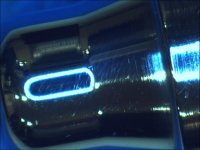I am assuming you guys have a chuck larger than 1/2"? These funnels won't fit in my drill press or mini lathe.
Rosewood
Yes I ran into this issue right away as the funnels are like .550 dia. There are a range of solutions.
Uniquetek makes an adapter just for this issue. I bought one and have it on hand but have not tried yet. So I don't know how true it will spin the funnel or if the set screw will gouge the part.
https://uniquetek.com/product/T1758
My first idea was to find a chuck that would adapt down. This turned out to be harder than I thought. Most 5/8" chucks have taper shanks of one kind or another. Like a lot of things these days, I found something on Amazon.
[ame]https://www.amazon.com/dp/B0811LYG8V?psc=1&ref=ppx_yo2ov_dt_b_product_details[/ame]
I used this in my handheld Makita. It worked but had a fair amount of wobble. I complained to the maker and they sent me another one. I have not tried the new one it to see if it runs truer.
Ultimately, I bought myself a drill press. I've wanted one for a long time and this kicked me over the edge. I bought the WEN model that is very popular on Amazon and the clincher was that they also offer a chuck upgrade that is keyless and goes to 5/8". So this is my current setup:
[ame]https://www.amazon.com/dp/B08ZVT5JKC?psc=1&ref=ppx_yo2ov_dt_b_product_details[/ame]
and
[ame]https://www.amazon.com/dp/B08R7V5B19?psc=1&ref=ppx_yo2ov_dt_b_product_details[/ame]
The chuck has a JT33 taper so if you already have a drill press with a JT33 taper, you can just buy the chuck. However, getting your old JT33 chuck off may not be so easy. The right way to do it is with a pair of tapers like these:
[ame]https://www.amazon.com/dp/B07HHJLBLG?ref=ppx_yo2ov_dt_b_product_details&th=1[/ame]
Thankfully, my WEN press came without the stock, 1/2" chuck not mounted. So I just installed the bigger chuck from the start.
Finally, a lathe is a go way to go because I like the horizontal orientation of the part. The Proxxon mini-lathe chucks up to 2.5 inches (but is a bit pricey). The funnel doesn't go through the center-hole in the chuck but it spins very nicely with the amount it does grab. You could use the live center to hold the other end if you wanted to press harder.
[ame]https://www.amazon.com/PROXXON-Precision-lathe-150-34150/dp/B0821LB28J/ref=sr_1_3?crid=7VJN2ZNTTC0K&keywords=proxxon+lathe&qid=1682003189&sprefix=proxxon+lathe%2Caps%2C149&sr=8-3[/ame]

